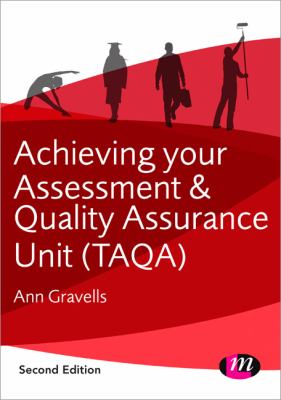| Acknowledgements | p. ix |
| Author statement | p. xi |
| Preface | p. xiii |
| Introduction | p. 1 |
| The structure of the book and how to use it | p. 1 |
| TAQA units and qualifications | p. 2 |
| How to achieve your units | p. 6 |
| Qualifications and Credit Framework | p. 7 |
| Abbreviations and acronyms | p. 8 |
| Principles and practices of assessment | p. 12 |
| Introduction | p. 12 |
| The role of assessment | p. 12 |
| Key concepts and principles of assessment | p. 24 |
| Minimising risks | p. 27 |
| Types of assessment | p. 28 |
| Methods of assessment | p. 32 |
| Assessing occupational competence in the work environment | p. 49 |
| Introduction | p. 49 |
| Assessment planning in the work environment | p. 49 |
| Making assessment decisions | p. 61 |
| Providing feedback | p. 65 |
| Standardising practice | p. 71 |
| Record keeping - assessment | p. 76 |
| Assessing vocational skills, knowledge and understanding | p. 84 |
| Introduction | p. 84 |
| Vocational assessment planning | p. 84 |
| Reviewing learner progress | p. 96 |
| Questioning techniques | p. 103 |
| The role of ICT in assessment | p. 108 |
| Continuing professional development | p. 115 |
| Principles and practices of internally assuring the quality of assessment | p. 122 |
| Introduction | p. 122 |
| The role of internal quality assurance | p. 122 |
| Key concepts and principles of internal quality assurance | p. 126 |
| Sample planning and the collection of information | p. 132 |
| Maintaining and improving the quality of assessment | p. 139 |
| Evaluation | p. 143 |
| Internally assuring the quality of assessment | p. 151 |
| Introduction | p. 151 |
| Internal quality assurance planning | p. 151 |
| Monitoring assessment activities | p. 153 |
| Decision making | p. 160 |
| Providing feedback to assessors | p. 168 |
| Record keeping - internal quality assurance | p. 170 |
| Principles and practices of externally assuring the quality of assessment | p. 174 |
| Introduction | p. 174 |
| The role of external quality assurance | p. 174 |
| Functions of external quality assurance | p. 179 |
| Planning external quality assurance activities | p. 184 |
| Tasks to perform when planning a visit or a remote monitoring activity | p. 187 |
| Evaluating the quality of assessment and internal quality assurance | p. 192 |
| Externally assuring the quality of assessment | p. 199 |
| Introduction | p. 199 |
| External quality assurance planning | p. 199 |
| External quality assurance activities | p. 202 |
| Making decisions | p. 215 |
| Providing feedback to centre staff | p. 221 |
| Record keeping - external quality assurance | p. 223 |
| Plan, allocate and monitor work | p. 228 |
| Introduction | p. 228 |
| Producing and using a work plan | p. 228 |
| Identifying and allocating responsibilities to team members | p. 235 |
| Monitoring the progress of others and the quality of their work | p. 240 |
| Communication skills | p. 243 |
| Updating the work plan | p. 247 |
| Appendices | p. 254 |
| Unit I: Understanding the principles and practices of assessment | p. 254 |
| Unit 2: Assess occupational competence in the work environment | p. 256 |
| Unit 3: Assess vocational skills, knowledge and understanding | p. 258 |
| Unit 4: Understanding the principles and practices of internally assuring the quality of assessment | p. 260 |
| Unit 5: Internally assure the quality of assessment | p. 262 |
| Unit 6: Understanding the principles and practices of externally assuring the quality of assessment | p. 264 |
| Unit 7: Externally assure the quality of assessment | p. 266 |
| Unit 8: Plan, allocate and monitor work in own area of responsibility | p. 268 |
| Index | p. 269 |
| Table of Contents provided by Ingram. All Rights Reserved. |

